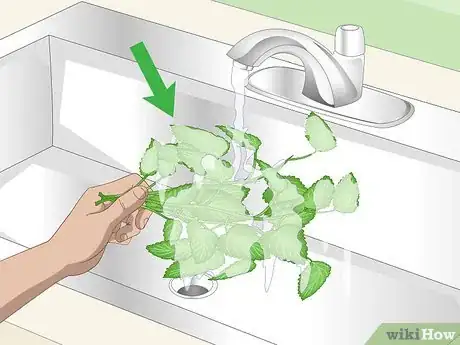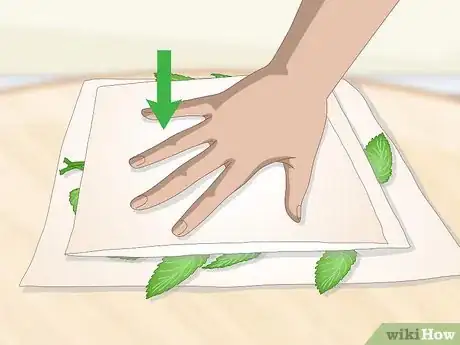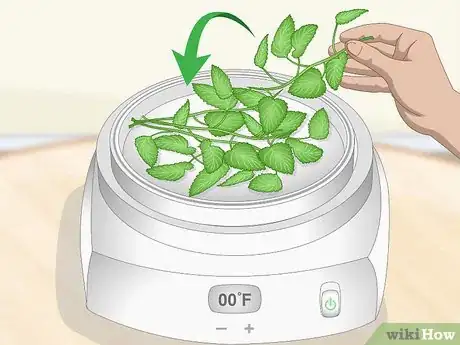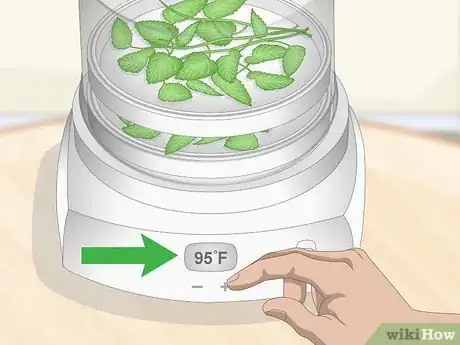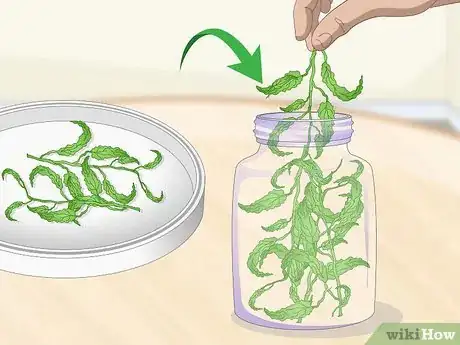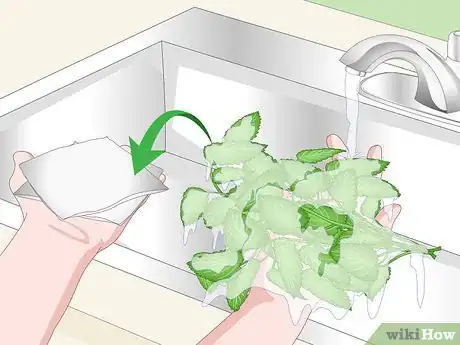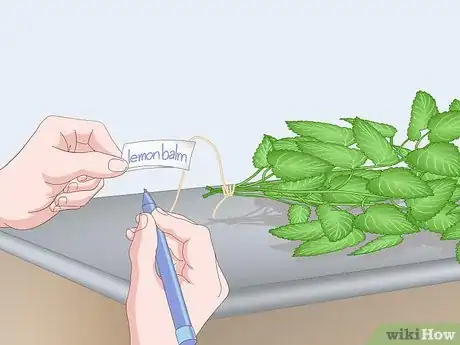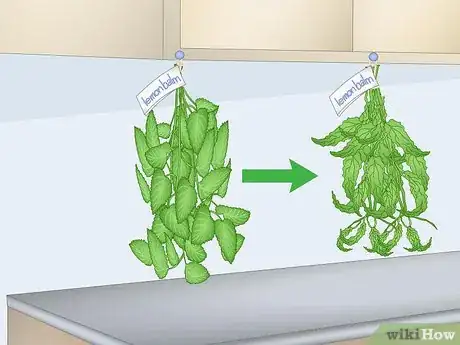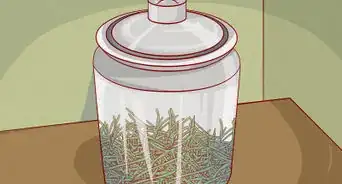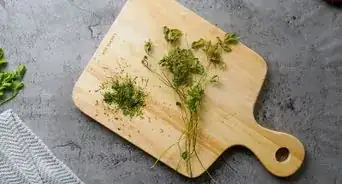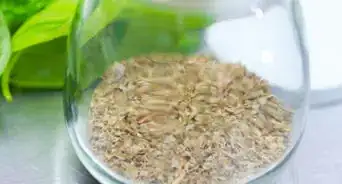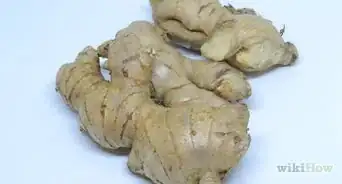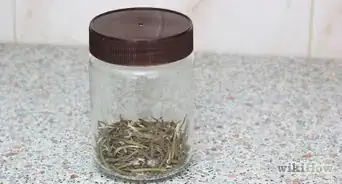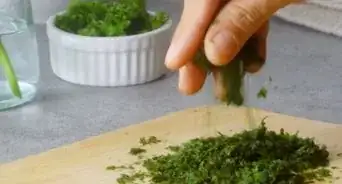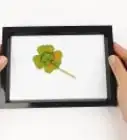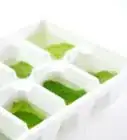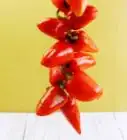X
This article was co-authored by wikiHow Staff. Our trained team of editors and researchers validate articles for accuracy and comprehensiveness. wikiHow's Content Management Team carefully monitors the work from our editorial staff to ensure that each article is backed by trusted research and meets our high quality standards.
This article has been viewed 34,072 times.
Learn more...
Lemon balm, also known as Melissa, is a popular herb used to promote health and well-being. Drying lemon balm preserves the quality and flavor of the plant for storage. An easy way to have lemon balm on hand is to dry it at home. Drying is simple and safe and you will soon have lemon balm when you want to relax for a good night's sleep!
Steps
Method 1
Method 1 of 2:
Using a Dehydrator
-
1Rinse the lemon balm stems and leaves in the sink. Spray down the lemon balm and swish it around. Thoroughly washing the lemon balm ensures that your herbs will be free of any dirt or insects from the garden.[1]
-
2Pat the stems and leaves dry to soak up remaining water. Line a paper towel or clean dish towel with the lemon balm and gently pat it dry with another sheet of paper towel or cloth.Advertisement
-
3Line the bottom of the dehydrator tray with the lemon balm. Spread the lemon balm out on the tray of the dehydrator. You should have a thin layer of plants and leaves.
- To avoid overcrowding, leave a little space between the plants. You do not want thick layers or clusters as this will prevent the machine from drying effectively.
-
4Set the temperature to low (around 95 °F (35 °C) ) in the dehydrator. Lemon balm is a tender herb and will do best on a low setting. Set the dehydrator's temperature on its lowest setting ( 95 °F (35 °C) ) and allow it to dry for 12–18 hours.[2]
- Consult the manufacturer's instructions before operating the dehydrator to be sure you've chosen the appropriate setting for your device.
-
5Store the dried lemon balm safely in a dry, airtight container. Move your dried lemon balm from the dehydrator to a container (such as a Mason jar or plastic bag) so it is ready to enjoy!
- You'll want to store it in a cool, dark place to retain maximum flavor.
Advertisement
Method 2
Method 2 of 2:
Air-Drying Lemon Balm
-
1Rinse off and dry the stems and leaves. Rinse stems and leaves under cool water to remove any dirt or debris. Dry the lemon balm by spreading it out on a paper towel and blotting gently to remove any surface moisture.
-
2Choose a warm and dry location in your home. To dry lemon balm, you will need to find a clean, dry, and dark location. It should be warm but avoid direct sunlight. A garage can be a good location, as can a kitchen cupboard or pantry.
- Lemon balm can be air dried outside but for optimal color and flavor, indoor drying is best.
-
3Bundle the stems and leaves of the lemon balm together with string and hang them up. Gather 5–7 stems and tie them together with kitchen string or thread. The lemon balm should resemble little upside down bouquets! Be sure to leave a little extra string before cutting it off so that it can be hung.[3]
- To ensure good air circulation, do not tie too many stems together.
-
4Label your lemon balm using tape or stickers to avoid confusion. Tag the herbs to designate a section for lemon balm so that you will be able to easily locate it later. This is especially important if you are drying other herbs nearby!
-
5Let your lemon balm hang until it is completely dry. Drying times will vary and depend on the humidity, heat, and air flow. It may take as little as one week or as long as three until you have dried lemon balm. Be patient!
- You can periodically check on it by touching and attempting to crumble leaves. When it is fully dry, it will crumble easily.
- Test to make sure the leaves are completely dry and brittle before you take them down.
-
6Store the dried lemon balm in airtight container or bags. Transfer your dried lemon balm into an airtight container. A jar or sealed plastic bag work well. Store it in a cool, dark place. Whole dried plants retain their essence longer than crumbled or ground ones, so hold off on crumbling it up for tea or seasoning until you are ready to use it.[4]
Advertisement
References
- ↑ https://kobra.uni-kassel.de/bitstream/handle/123456789/2011040637200/DissertationSPCuervoAndrade.pdf;jsessionid=3BCC838A810B06FE286A4671C1A4E9C6?sequence=3
- ↑ http://www.gettystewart.com/how-to-harvest-and-dry-lemon-and-lime-balm/
- ↑ https://kobra.uni-kassel.de/bitstream/handle/123456789/2011040637200/DissertationSPCuervoAndrade.pdf;jsessionid=3BCC838A810B06FE286A4671C1A4E9C6?sequence=3
- ↑ http://www.ecofarmingdaily.com/growing-using-lemon-balm/
About This Article
Advertisement
